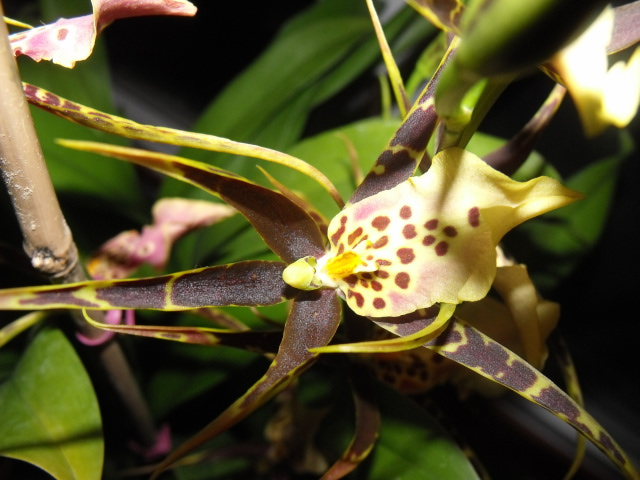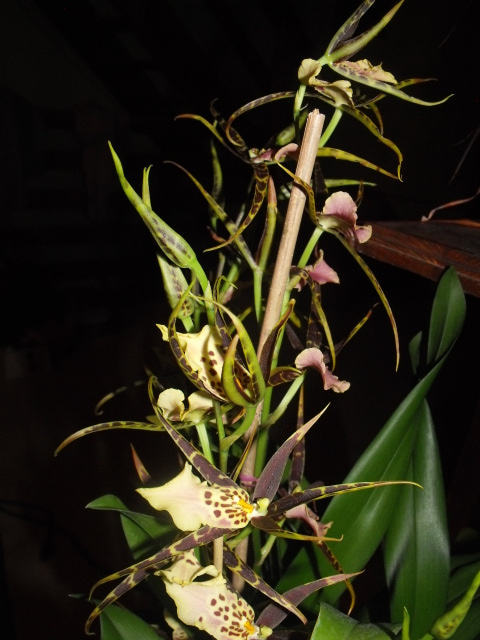Question My Orchid
My Orchid
 plant in bloom
plant in bloom
QUESTION: Hi, i'm not sure what kind of orchid i have. i do think it is some kind of hybrid. The tag when I bought it said Oncidium, How ever I've been looking at the web and it seems to have more resemblance to brassidium strains. At one point i had 24 blooms on it and now they have all dropped off but one. i have been careful not to overwater and it often has "sugar sap" on it which as far as i can tell that means its a happy plant. I am wondering how to care for it now? Should i cut the stalks? I'm quite new at orchids as this is my first one!!! I'll include a picture while it was in bloom so you have a better idea of what I should do!! Thanks in Advance for your guidance :)
ANSWER: Laurel, you are right that this is what is referred to as an oncidium alliance hybrid. The genus Oncidium, however, is closely related to many other genera with which it can form hybrids. Your plant does resemble Brassidium which is a hybrid between Oncidium and the genus Brassia. However, it is often difficult to distinguish between the different Oncidium hybrids. Other genera in the oncidium alliance include Aspasia, Cochlioda, Odontoglossum,and Miltonia. If the genus Miltonia is hybridized with Oncidium and Brassia, the result is an intergeneric hybrid called Alicerara. Without a tag, we will never be able to be absolutely sure that your plant is a Brassidium. The good news is that when two or more genera are hybridized, the result is a plant that is usually intermediate in its growing conditions. I recommend temperatures between 60-80 degrees F. Most of the oncidium alliance hybrids prefer medium to high light. The higher the light, usually, the more floriferous. You can remove the old flower spikes as the plant will not rebloom on these. If you want to grow this plant on to specimen size, it would be good to repot it in fresh orchid potting mix when new growth emerges. Strain out the fine particles before using a commercial grade of orchid potting mix and, if it is dry, be sure to soak the potting mix prior to use. It is possible to divide these plants into three to four bulb divisions-- when the plant has at least 8 pseudobulbs. Grow it relatively dry until new growth appears-- more orchids die from being too wet than being too dry. In fresh potting mix you can water it thoroughly every two weeks and, when in new growth, weekly. Old potting mix tends to stay wet too long and leads to root rot. These plants like to be tightly potted so use a pot into which the root mass will just fit and be sure the pot has plenty of drainage holes.
---------- FOLLOW-UP ----------
QUESTION: ok, so new growth as in flower spikes/ and i should keep it mostly dry until i see new ones? then I need to re pot it in orchid potting mix/? when i got it i watered after 14 days and have only watered a drip or two of water since then. i didn't want to ruin its beauty!!!!
AnswerLaurel, new growth means vegetative growth. When the plant finishes flowering, these old flower spikes should be removed. The plant which gave rise to the old flower spikes will rest for several months and then, will send up new growth from the base of the old pseudobulbs. This is repotting time. This new growth will mature into new pseudobulbs and, ultimately, those new pseudobulbs will send up flower spikes which will produce flower buds which will open into flowers. New flower spikes can only originate from a new pseudobulb and old pseudobulbs and their old flower spikes will not reflower. However, the old pseudobulbs give rise to new pseudobulbs from their bases-- hence are critical to future new growth.







